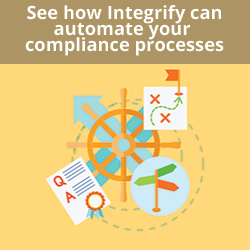Ensuring Compliance by Improving User Experience
Table of contents

_ Note : This is a guest post by Cindy Cook DeRuyter who spent more than 19 years in financial compliance and operations roles for firms including RSM Wealth Management, Nuveen Investments and US Bancorp Asset Management_
Whatever your industry or line of business, you likely have certain compliance requirements you need to follow. Whether those are HR requirements driven by labor laws, regulatory in nature, or stem from other laws or regulations, you and your employees need to dot your "i"s and cross your "t"s in order to remain in compliance.
In many organizations, getting 100% of employees to participate by returning required acknowledgments, submitting compliance surveys, or responding to documentation requests is an ongoing struggle, even after implementing automated workflows or other tools to help ensure compliance.
So, what is really at stake?
The real costs of failing to comply with laws and regulations are potentially staggering. As Intuit outlined in thisJanuary 2015 blog post(opens in a new tab), depending on the law or regulation in question, companies can face potential lawsuits, regulatory audits, fines, and, in instances of extreme non-compliance, companies' legal business structures can even be threatened.
Negative press, something every company wants to avoid, can also be a consequence of non-compliance with certain laws or regulations. And, when your customers have doubts about your company, you may end up facing a long, uphill battle to win them back.
Why do employees fail to comply?
 (opens in a new tab)There are probably as many reasons for employees' non-compliance as there are different rules and regulations affecting your business. You may have a rogue employee who doesn't care about your business' compliance, or you may just have employees who don't understand the importance of certain requirements. When you have employees, you will likely always have some HR or training issues to contend with.
(opens in a new tab)There are probably as many reasons for employees' non-compliance as there are different rules and regulations affecting your business. You may have a rogue employee who doesn't care about your business' compliance, or you may just have employees who don't understand the importance of certain requirements. When you have employees, you will likely always have some HR or training issues to contend with.
Businesses also need to look at their users' experience; if employees find that taking action to be in compliance is confusing or difficult, at best, they are going to waste extra time on it. At worst, employees will give up trying to figure out how to comply, putting you, your company, and potentially your customer base at risk.
The importance of the end user or employee's experience when it comes to complying with various legal or regulatory requirements cannot be overstated. Simply put, when you make compliance easy for users, you are much more likely to be, and to remain, in compliance.
Workflow automation can help
As we shared in a recent blog post, automating compliance workflows can drastically improve compliance with required policies simply because you've made the process of compliance easier for employees to understand.
As PWC stated in this Financial Services Viewpoint(opens in a new tab) publication addressing ways banks can manage compliance and operational risk:
Technologies are being deployed to increase coverage and focus on anomalies through automated testing and forensic testing techniques. Shared platforms are also improving the efficiency of the compliance management process through automated issue tracking, streamlined reporting, storage and retrieval of work products, and knowledge management.
However, companies wanting to start using automated workflows need to be deliberate about content creation and implementation, so that forms and user workflows are developed with input from end users. Companies that rush to put workflows in place run the risk of inadvertently making things harder for end users. If employees can't see how the workflows will make compliance simpler, they are not likely to be motivated to use them.
Bad user experiences may lead to non-compliance
No matter how great you think you've made systems, workflows, or any other tools, they are only as good as their users think they are. Users who don't like, or don't understand how to use your workflows will find ways to work around them, likely leading to non-compliance for your company.
For example, a Deloitte Consulting partner once cited an example of a power plant that implemented tools to manage plant maintenance, however, because users found the system complicated and confusing, only a fraction of the total service requests were entered. When the company realized what was going on, they were able to change the user experience for the better by implementing simple changes to the ways users had to interact with the system. In short order, they reached nearly full compliance without incurring significant training costs or going through a major systems overhaul.
In addition to making processes easier to understand via automation, companies can greatly increase compliance by employing a user portal that provides "one-stop shopping" for all compliance workflows. A centralized portal removes any confusion or doubt about where employees need to go to initiate compliance procedures. Rather than scattering processes and forms among several different intranets, document management systems and Web sites, design a simple, uncluttered place for employees to quickly find and launch the correct process.
Keep forms streamlined by only collecting the information that's truly necessary to the process. This will make the required fields less of a burden on employees. In addition, follow best practices for form design. There are numerous resources for keeping forms as user-friendly as possible. Or work with your workflow management vendor to design and test your forms before implementation.
Users need to see the positive changes first-hand
The adage "seeing is believing" is definitely applicable when it comes to getting employees to adopt workflows that can help improve compliance. Automated workflows have all kinds of benefits beyond better compliance; for example, the turnaround time for tasks is improved, processes are simpler and take less effort, and accuracy is improved.
However, just telling employees that they are going to realize all of these wonderful benefits in the way they do their jobs is generally not enough. When you are able to demonstrate the positive outcomes users and teams will experience, that's when excitement builds, and that's when your users will begin to get on board with using the workflows. Let's face it: outside of the HR or compliance departments, most employees are probably not motivated by better compliance effectiveness; they want to see and understand how automated workflows will affect them, and how their jobs will become easier.
Don't underestimate the power of communication!
When you've gotten user buy-in and help to design your forms, processes, and workflows, you may be tempted to sit back and relax after implementation. After all, everything is in place and things will run like clockwork from now on, right? Well, not necessarily. Remember that, although you are implementing technology with the end goal of improving compliance, you still have a human workforce.
Keeping the lines of communication open long after the initial roll-out is an often overlooked, but critical, step. Remember that employees' suggestions about the design for forms and workflows were conceptual; after they've been implemented, the users may discover that small changes could provide added benefits and streamline processes. Have a pre-defined method for users to submit service requests or suggested tweaks.
Then, when you do make changes that will affect how users do their jobs, make sure to communicate those changes so everyone is on the same page. Conduct training as needed and appropriate.
Having happy users over the long-term is just as, if not more important than having happy users at the outset.
Conclusion
Simply implementing automated compliance workflows is not, by itself, enough to ensure better compliance with applicable laws and regulations. However, when you get buy-in from the end users at every level, and design forms, processes and workflows to meet those users' needs, you will be well on your way to ensuring compliance for your company.





